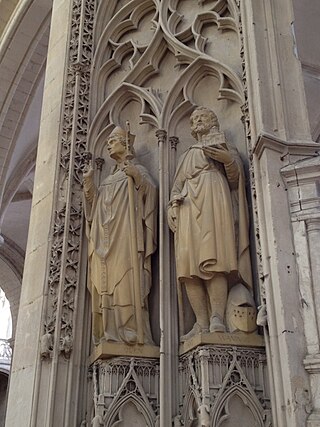
Charles Martel, Martel being a sobriquet in Old French for "The Hammer", was a Frankish political and military leader who, as Duke and Prince of the Franks and Mayor of the Palace, was the de facto ruler of the Franks from 718 until his death. He was a son of the Frankish statesman Pepin of Herstal and a noblewoman named Alpaida. Charles successfully asserted his claims to power as successor to his father as the power behind the throne in Frankish politics. Continuing and building on his father's work, he restored centralized government in Francia and began the series of military campaigns that re-established the Franks as the undisputed masters of all Gaul. According to a near-contemporary source, the Liber Historiae Francorum, Charles was "a warrior who was uncommonly ... effective in battle".

The Carolingian dynasty was a Frankish noble family named after Charles Martel and his grandson Charlemagne, descendants of the Arnulfing and Pippinid clans of the 7th century AD. The dynasty consolidated its power in the 8th century, eventually making the offices of mayor of the palace and dux et princeps Francorum hereditary, and becoming the de facto rulers of the Franks as the real powers behind the Merovingian throne. In 751 the Merovingian dynasty which had ruled the Franks was overthrown with the consent of the Papacy and the aristocracy, and Pepin the Short, son of Martel, was crowned King of the Franks. The Carolingian dynasty reached its peak in 800 with the crowning of Charlemagne as the first Emperor of the Romans in the West in over three centuries. Nearly every monarch of France from Charlemagne's son Louis the Pious till the penultimate monarch of France Louis Philippe have been his descendants. His death in 814 began an extended period of fragmentation of the Carolingian Empire and decline that would eventually lead to the evolution of the Kingdom of France and the Holy Roman Empire.

Chlothar III was King of the Franks, ruling in Neustria and Burgundy from 657 to his death. He also briefly ruled Austrasia.

Childeric II was King of the Franks in the 7th century. He ruled Austrasia from 662 and Neustria and Burgundy from 673 until his death, making him sole king for the final two years of his life.

Ebroin was the Frankish mayor of the palace of Neustria on two occasions; firstly from 658 to his deposition in 673 and secondly from 675 to his death in 680 or 681. In a violent and despotic career, he strove to impose the authority of Neustria, which was under his control, over Burgundy and Austrasia.

Dagobert II was a Merovingian king of the Franks, ruling in Austrasia from 675 or 676 until his death. He is one of the more obscure Merovingians. He has been considered a martyr since at least the ninth century.

Leodegar of Poitiers was a martyred Burgundian Bishop of Autun. He was the son of Saint Sigrada and the brother of Saint Warinus.
Liber Historiae Francorum is a chronicle written anonymously during the 8th century. The first sections served as a secondary source for early Franks in the time of Marcomer, giving a short breviarum of events until the time of the late Merovingians. The subsequent sections of the chronicle are important primary sources for the contemporaneous history. They provide an account of the Pippinid family in Austrasia before they became the most famous Carolingians.

Clovis III was the Frankish king of Austrasia in 675 and possibly into 676. A member of the Merovingian dynasty, he was a child and his reign so brief and contested that he may be considered only a pretender. He is sometimes even left unnumbered and Clovis IV is instead called Clovis III. The only source for his reign is the contemporary Suffering of Leudegar.

Audoin, venerated as Saint Audoin, was a Frankish bishop, courtier, hagiographer and saint. He authored Vita Sancti Eligii which outlines the life and deeds of Eligius, his close friend and companion in the royal court and the Church.
Drogo was a Frankish nobleman, the eldest son of Pippin of Heristal and Plectrudis. He was the duke of Champagne from the early 690s.

Jumièges Abbey, formally the Abbey of St Peter at Jumièges, was a Benedictine monastery. Its ruins are situated in the commune of Jumièges in the Seine-Maritime Departement of Normandy, France.

Philibert of Jumièges was an abbot and monastic founder, particularly associated with Jumièges Abbey.
Ursinus the Abbot was an abbot of Saint-Martin at Ligugé, and presumed biographer of Saint Leodegar. He began his career as a monk in the monastery of Saint-Maixent at Poitiers in Neustria.

The Battle of Lucofao was the decisive engagement of the civil war that afflicted the Frankish kingdoms during and after the reign of Dagobert II (676–79). In the battle, the Neustrian forces of Theuderic III and his majordomo Ebroin defeated the forces of Austrasia under the dukes Pippin and Martin.
The Battle of Autun was a pitched battle in 642 or 643, concluding a feud between Flaochad and Willebad, two magnates of the Merovingian kingdom of Burgundy. The battle is recounted in detail in the final chapter of the contemporary Chronicle of Fredegar and also in the biographies of saints Eligius of Noyon and Sigiramn. While Fredegar seems hostile to Willebad, the hagiographers are hostile to Flaochad. The anonymous author of Fredegar may have been an eyewitness.
Sigrada of Alsace was a Franco-Burgundian countess and mother of Ss. Warin, and Leodegar, and grandmother of St. Leudwinus.

The Gesta Dagoberti, fully Gesta domni Dagoberti regis Francorum, is an anonymous Latin biography of Dagobert I, king of the Franks (623–639). It combines deeds from the life of Dagobert with numerous accounts of miracles to present Dagobert as a saint and the founder of the Abbey of Saint-Denis. It was written in the early 9th century. As a historical source, it is "extremely unreliable", but not totally useless.
The Deeds of the Bishops of Cambrai is an anonymous Latin history of the diocese of Cambrai. It was commissioned around 1024 by Bishop Gerard I of Cambrai and completed shortly after his death in 1051. It is the work of two authors.